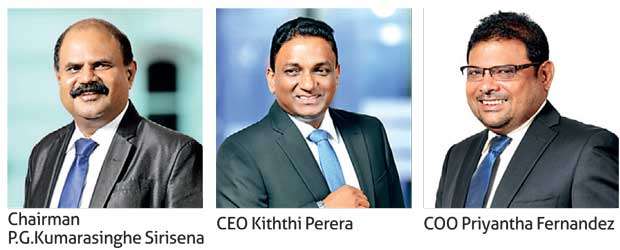26 Nov 2018 - {{hitsCtrl.values.hits}}

Sri Lanka Telecom PLC (SLT), the leader in fixed line services and number two in mobile services, reported higher revenues and contained costs to post strong profits for the quarter ended September 30, 2018 (3Q18), but a sizeable slice of earnings had been wiped off by a hefty foreign exchange loss.
SLT reported revenues of Rs.20.6 billion for the three months under review, up 8.4 percent year-on-year (YoY).
The operating profit before depreciation and amortisation was up 26.4 percent YoY to Rs.6.5 billion as the group contained the increase in operating costs to 2.2 percent YoY.
Fitch Ratings Lanka last week affirmed SLT’s national long term rating at ‘AAA’ with a Stable outlook, the highest rating on the Sri Lankan scale considering the telco’s strong State linkages.
The government has 49.50 percent stake and Malaysia’s Usaha Tegas Sdn Bhd being SLT’s second largest shareholder holds 44.98 percent stake. The Employees’ Provident Fund (EPF) has 1.40 percent stake being the third largest shareholder.
Fitch expects SLT to have negative free cash flow during 2019 to 2020 with an estimated negative free cash flow of between Rs.2.0 billion to Rs.3.0 billion for 2018 due to large capital expenditure (capex) required to expand fibre infrastructure and 4G mobile networks.
Fitch said that SLT’s capex is likely to remain significantly high during 2019—at an estimated 28-30 percent of revenues as it aims to complete its 4G-population coverage to around 95 percent by the end of that year.
“We expect SLT to continue to invest in expanding fibre coverage as it targets to connect about 1 million homes by 2020-2021 from an existing 70,000 homes currently. Typically, SLT would need to lay fibre for at least 2 million homes to get half of the households connected. We expect SLT’s fibre investments to have low returns due to the country’s low broadband tariffs”, Fitch said.
Meanwhile, as a notable event during the period, the group reported a foreign exchange loss of Rs.564 million for the quarter, while the nine months loss was Rs.1. 1 billion.
SLT did not specify the reasons for the whopping loss, but it had Rs.53 billion in debt out of which 25 percent was denominated in US dollars.
However, the group has cash worth Rs.12 billion and committed undrawn bank lines worth Rs.13.5 billion, which is sufficient to fund its short-term debt of Rs.13.5 billion, Fitch showed.
Meanwhile, the SLT group reported earnings of 64 cents a share or Rs.1.2 billion for the quarter under review compared to 40 cents or Rs.730 million in earnings reported for the same period last year.
For the nine months ended September 30, 2018, the group reported earnings of Rs.2.21 a share or Rs.3.99 billion compared to Rs.1.79 a share or Rs.3.2 billion a year ago.
Revenue for the nine months was Rs.60.1 billion, up 6.6 percent YoY on fixed broadband and mobile usage and the operating profit (before depreciation and amortisation) was Rs.5.2 billion, up 53 percent YoY.
Fitch said barring any tax shocks, SLT’s revenues could grow by mid single digits during 2019 and 2020 driven by data and fixed broadband.
“We expect 4G smartphone penetration to improve from the current 25 percent with the proliferation of cheaper Chinese phones”, Fitch said adding that the government’s recent removal of floor rates on voice calls will have limited impact on growth.
Fitch however cautioned that SLT’s National Long-Term Rating could come under pressure if it were to carry out a debt-funded acquisition of Bharti Airtel Limited’s (BBB-/Stable) Sri Lankan subsidiary, Airtel Lanka.
“However, any rating action will be based on the acquisition price, funding structure, and the financial and operating profile of the combined entity”, it added.
Fitch maintains a Stable outlook on the Sri Lankan telecom sector.
“We expect the sector’s cash generation to improve, driven by higher mobile and broadband data usage, which however, will be insufficient to fund the large capex requirement, leading to negative FCF.
“We also expect the average operating EBITDAR margins to remain stable at around 34 percent (2018 estimate: 34 percent), driven by improving economies of scale in the data and home broadband segment, offsetting the negative impact of the changing revenue mix”, Fitch noted.
16 Nov 2024 3 hours ago
16 Nov 2024 3 hours ago
16 Nov 2024 4 hours ago
16 Nov 2024 4 hours ago
16 Nov 2024 6 hours ago